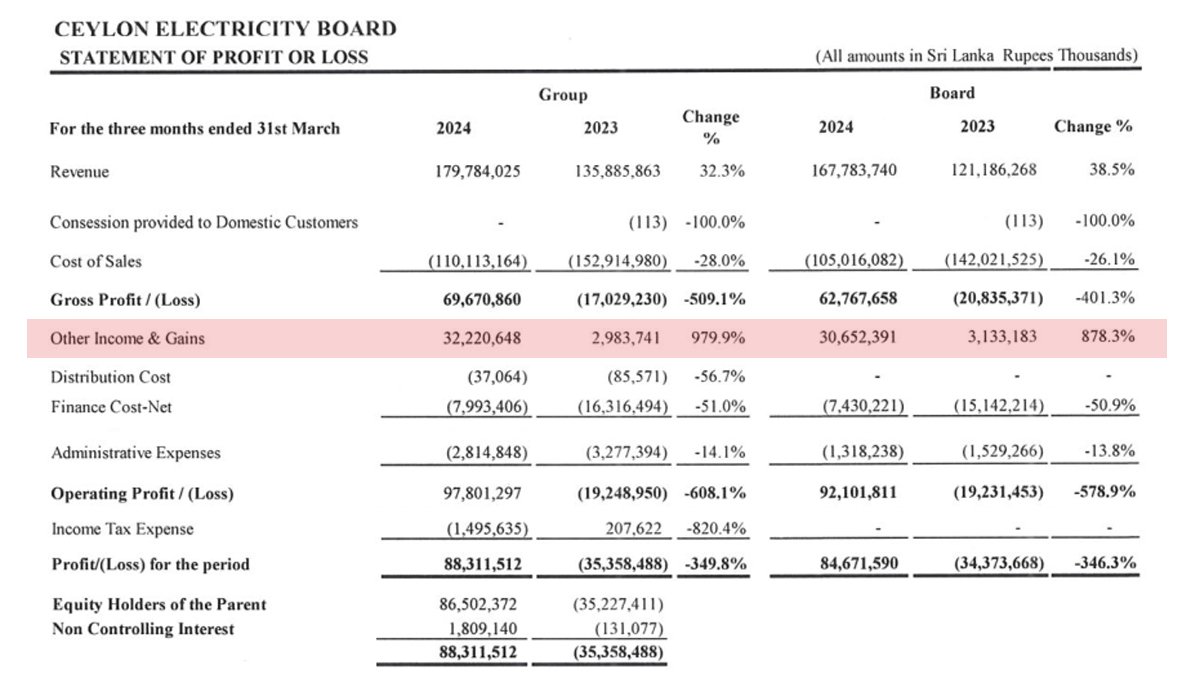
ECONOMYNEXT – Sri Lanka’s state-run Ceylon Electricity Board group has reported profits of 86 billion rupees with the help of 25.9 billion rupees of capital gains from a transfer of shares, interim accounts show.
The rupee also appreciated in the quarter which keeps imported fuel prices low.
As a standalone entity, the Ceylon Electricity Board, made profits of 84.6 billion rupees in the March quarter.
CEB’s revenues rose 38.5 percent to 167 billion rupees in the March 2024 quarter, while cost of sales fell 26.1 percent to 105.0 billion rupees giving gross profits of 62.7 billion rupees.
The CEB also reported 30.6 billion rupees of other incomes and gains in the March quarter, up from 3.1 billion rupees last year.
Other Income and Gains
The utility said it made a 25.9 billion rupee capital gain from transferring LTL Holdings shares to West Coast Power an IPP in which other entities have a majority holding.
In the quarter the rupee also appreciated.
A rupee appreciation will help reduce the carrying cost of dollar loans and also reduce the cost of imported thermal fuels and maintenance costs of spares.
The central bank allowed Sri Lanka’s exchange rate to appreciate from 324.40 rupees in December 2023 to 300.17 on March 2024 amid deflationary policy and weak private credit allowing imported fuel costs also to fall.
Especially after 1978, after rate cuts drove the country into balance of payments crises, the central bank had collected reserves with free market interest rates, but has not usually allowed the exchange rate to re-appreciate despite generating a BOP surplus with deflationary policy.
Un-anchored Bad Money
Before 1978, when an apparently doctrinally foxed International Monetary Fund abandoned both external and specie anchors simultaneously after the Fed closed its gold window triggering the Great Inflation period, Sri Lanka also did not depreciate its currency, analysts have pointed out.
Related Why the IMF is hated now and is backing bad money in Sri Lanka and Latin America
Since it was set up in 1951, the central bank has printed money under various dual anchor conflicting Saltwater-Cambridge ideologies (re-financing rural credit, sterilizing outflows, potential output targeting, yield curve targeting) to create forex shortages and currency crises and started to go the IMF from the mid-1960s.
From 1978, after the IMF’s second amendment to its Articles denied the central bank a credible external and domestic anchor simultaneously, the currency stated to depreciate steeply.
The government was therefore unable to balance its budget and state enterprises were also unable to balance their budgets running large losses whenever the rupee fell and energy prices went up.
After abandoning its external and specie anchor the central bank followed a anchor conflicting regime involving money supply targeting without a floating exchange rate in the 1980s.
The ideology was rejected in toto by Singapore, Malaysia, Hong Kong, Thailand and China.
Since the end of a civil war macro-economists have followed inflation targeting without a floating exchange combined with extreme macro-economic policy to target potential output, eventually driving the country into external default.
Budgets went haywire in the early 1980s as the rupee fell, despite then President JR Jayawardene cutting subsidies and ending price controls (administered prices) two years earlier, in reforms that Singapore’s economic architect and one-time Finance Minister Goh Keng Swee said were “economic reforms which most people had considered politically impossible.”
Goh who set up a currency board in Singapore rejecting Cambridge-Saltwater ideology, warned JR not to destroy the rupee.
“Exchange rate policies involve many complicated technical issues which I do want to discuss here,” he said.
“On balance, the disadvantage of a depreciating rupee will, I believe, outweigh the advantages. Most of the products whose prices are administered are ether wholly imported or contain a high import content. About a quarter of rice consumption is imported.
“All wheat from which four and bread are produced is imported. The same holds true of kerosene and milk powder.
“Bus fares ware largely determined by the rupee price of imported oil and spare parts. Fertilizers are also mostly imported.”
At the time Sri Lanka had hydro-electricity.
Capital Injections
Some of the CEB’s dollar loans were been taken over by the central government after the steepest currency collapse in the history of the central bank in 2022 and external default.
The CEB’s contributed capital as at end March 2024 was 991.4 billion rupees up from 865.1 billion rupees.
With the March quarter profits with some financial engineering involving the asset sale and the government equity injection, the CEB’s group accumulated losses reduced to 456 billion rupees from 575 billion rupees.
The CEB ran large losses as the regulator failed to raise tariffs as macro-economists printed money to target potential output over the past decade.
From 2011 to 2022 the rupee fell from 113 to 370 to the US dollars as the central bank ran un-anchored monetary policy the regulator only raised prices in 2022.
Energy Minister Kanchana Wijesekera said the last price cut was also made possible due to rupee appreciation.
With no potential output targeting (no inflationary open market operations), the country has started to recover from the stability that has been provided up to now amid weak private investment credit.
Sri Lanka’s private credit is now starting to recover.
Based on past trends of using statistics instead of classical economic principles (cutting current current interest rates with inflationary open market operations of a money monopoly based on historical inflation rates under ‘data driven monetary policy’ without regard to domestic credit) analysts have warned of a return to monetary instability under potential output targeting. (Colombo/May19/2024)
